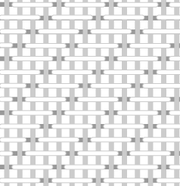Twill
Twill weaves can be classified from four points of view: In a twill weave, each weft or filling yarn floats across the warp yarns in a progression of interlacings to the right or left, forming a pattern of distinct diagonal lines.
In addition, twill's durability, wrinkle-resistance, and low maintenance make it ideal for a range of other items, such as jackets, pants, backpacks, and even draperies.
The fewer interlacings in twills as compared to other weaves allow the yarns to move more freely, and therefore they are softer and more pliable, and drape better than plain-weave textiles.
When there are fewer interlacings, the yarns can be packed closer together to produce high-count fabrics.
With higher counts, including high-count twills, the fabric is more durable, and is air- and water-resistant.
Even-sided twills have the same amount of warp and weft threads visible on both sides of the fabric.



